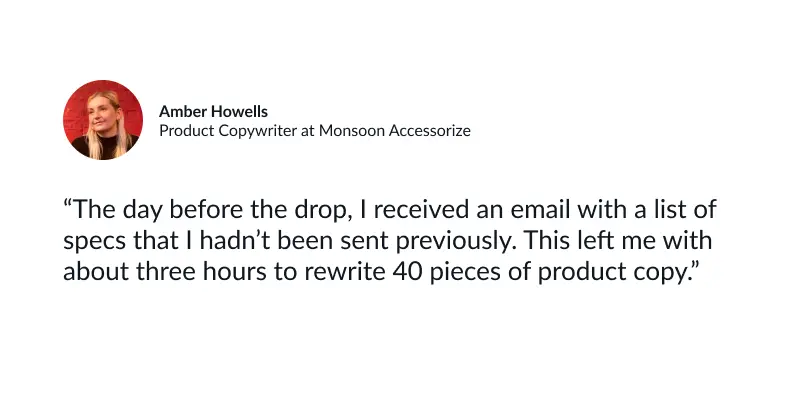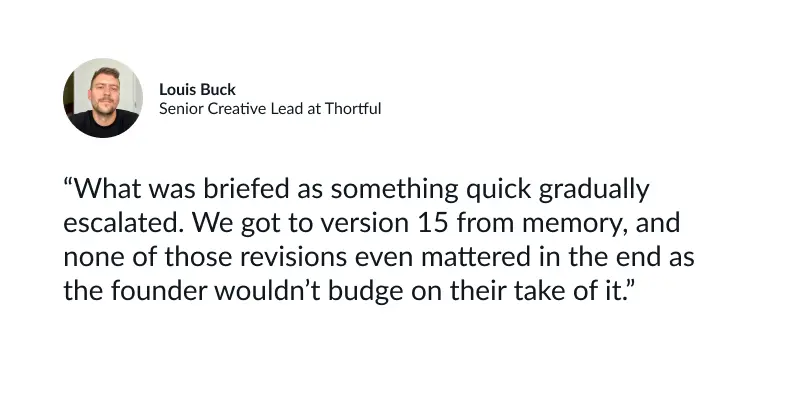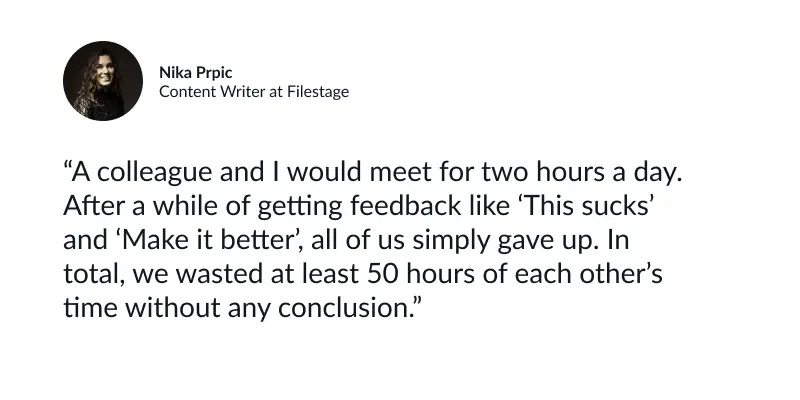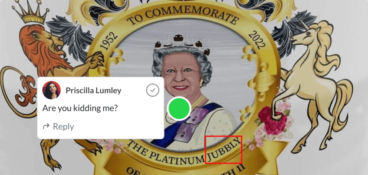If you’re a writer, designer, or anyone else in the business of making stuff, chances are that you’ve fallen foul of some feedback faux-pas over the years.
And while these experiences always leave you pulling your hair out in the moment, they also hold valuable lessons on how we can work together better in the future.
So what better time than Halloween to share some nightmarish stories from creatives around the world and the lessons they learned along the way.
Ready? Here’s Johnny!
Say hello to clearer, faster feedback
Get collaborative feedback right on top of your work with Filestage.
1. The tale (and fail) of the incomplete brief
“I had a huge collection of coats that needed product copy with a really tight deadline,” says Amber Howells, Product Copywriter at Monsoon Accessorize. “I completed the task and sent it off for feedback. And it was approved.”
So far so good!
“However” – ah, here we go – “three days later, the day before the drop, I received an email from their senior with a list of specs that I needed to include in the copy which I hadn’t been sent previously. This left me with about three hours to rewrite 40 pieces of product copy.”

This scenario is all too common for creatives, causing frustrating rework that takes time away from other projects, slashing efficiency and productivity.
Top tip 💡
Before you get started on any creative task, make sure your brief is crystal clear and includes specifications like word count, dimensions, or duration.
Even better, create a content request form using a free tool like Google Forms or Typeform. This will make sure that stakeholders include all the necessary information upfront, instead of causing a panic later in the process.
As Howells explains, “It taught me that communication really is key. Make sure you gather all the information before beginning a task, and ask as many questions as possible.”
2. The curse of the “quick job”
“This has happened a number of times over my career,” says Louis Buck, Senior Creative Lead at Thortful. “What was briefed as something quick and simple gradually escalated up to the desk of senior board members and their uncompromising opinions.”
“I remember writing a line for a 48-sheet London Underground advert where the copy was simple enough to land the action and packed the right amount of emotion, too. Perfect.”
“But after the first eyes of feedback I knew I was in for a rollercoaster of grammatical opinions. We got to version 15 from memory. And none of those revisions even mattered in the end as the founder wouldn’t budge on their take of it.”

Top tip 💡
Find out who your stakeholders are upfront and involve them in the creative process as early as possible.
By inviting them to brainstorms or getting their points of view on references before you get started, you’re more likely to deliver something that hits the mark and sails through the design review process.
And if you’re really having trouble getting ad concepts past your senior stakeholders, verify your ideas with some customers first. That way, the discussion becomes less about creative opinions and more about what works for your target audience.
3. The mystery of the hot potato
“My manager and CEO asked me to take part in a product communication project,” says Nika Prpic, Content Writer at Filestage. “A product manager and I inherited the project from the previous communications manager, who said, ‘We never managed to finish this and I don’t really know what will come out of it, but let’s just try.’”
“The goal was to find a way to communicate all our features while pointing out the benefits of each feature for various use cases,” says Prpic. “At least I think it was!”
“A colleague and I would meet on a daily basis for a few weeks for two hours a day. And whenever the CEO would join us, his response would be, ‘This sucks, make it better’. Then he would work with us on each separate tagline for each feature. This would again take ages.”
“After a while of getting feedback like ‘This sucks’ and ‘Make it better’, all of us simply gave up. In total, we wasted at least 50 hours of each other’s time without any conclusion.”

Top tip 💡
Team and business priorities change from one quarter to the next. So if a half-baked project lands on your plate, take a few steps back to realign on goals before you get started.
“The fact that we didn’t know the ultimate goal of the project kept us from creating something good and useful for the team,” says Prpic. “Expectations were constantly changed throughout the project and were defined as, ‘let’s make something great’, which was very vague.”
4. The epic saga of email chain hell
“While working for a well-known IT software company,” says Douglas McKerson, Founder and Managing Director at Longship Marketing, “I would very often be involved in extremely long, complicated email chains. Several C-level leaders would be involved to review the content of a customer marketing email.”
“This email chain often began with my CMO sharing a text with them that I had shared with him for approval. They often had no context about the email’s purpose nor the structural elements that dictate criteria for the length of texts.”
“By the time I was copied in, 20 emails had been exchanged, with some providing feedback directly within the email text and others attaching their own modified Word files helpfully titled ’email-text-final-v13-dw-cd-sd.docx’ – with the suffix letters being added to show initials for the reviewers.”

“No documents had tracked changes, and it was utterly unclear whether subsequent feedback was on the text I had written or that a C-level outside of marketing had butchered. And, of course, feedback was often contradictory and unclear whether it was a suggestion or a demand.”
“Eventually, the text that went out to customers was the most politically acceptable and definitely not the most effective for our goals. The result was always a huge sense of frustration on my side, as ultimately, I was judged on the results of the email dispatch, and yet I had no sense of ownership for the text and no mechanism to respond to individual pieces of feedback.”
Say hello to clearer, faster feedback
Get collaborative feedback right on top of your work with Filestage.
Top tip 💡
Email feedback is a fast-track ticket to chaos and confusion. So when sharing work with multiple stakeholders, you’re better off using a dedicated content review platform.
And when it comes to communicating with stakeholders, don’t be afraid to steer the ship and make your voice heard. As McKerson explains, “I now know that decision-makers will often give input when asked but are more than willing to be presented with an argument for why something is crafted in a particular way. Over time, reviews with the same stakeholders should become easier as their trust in your expertise grows.”
5. The flippy-flop of horrors
Today, budgets for creative projects are tighter than ever – especially for smaller brands and studios. So the last thing you need is stakeholders flip-flopping on their previous feedback.
And yet, all too often, that’s exactly what happens.
“The client initially requested a different style for an ad we were developing,” says Karla Skok, Freelance 2D Animator & Storyboard Artist. “After our team had already put considerable effort into sketching the character in multiple versions and styles, the client had a change of heart and reverted to the original style.”
It’s always frustrating to feel like you’ve wasted time on a project. Even if you preferred the previous version, you’re often left wondering where the next U-turn will come from.

Top tip 💡
Take the time to get aligned on visual references before starting any serious work. That way, you can be confident that you and your stakeholders are aligned on the look and feel of your project.
“I’ve realized that not all clients can envision things the same way we do initially,” says Skok. “Using references and clear communication is essential to bridge that gap and ensure everyone is on the same page.”
On top of that, Skok suggests that you “keep a good record of client communication, including feedback, approvals, and any alterations. Having this documented history can be very helpful when addressing client concerns and managing changes.”
One way to do this is by using a visual feedback tool. This gives you a centralized space to share comments, annotations, and attachments on everything from documents to animations.
Final thoughts
Whatever your role in the creative process, I hope this article has given you some ideas to optimize your feedback rounds.
If messy review rounds and misaligned stakeholders are holding you back, Filestage’s approval software can help. You can set up custom workflows, get visual feedback, and track approvals, all in one place!
Want to give it a try? Start a free trial →





